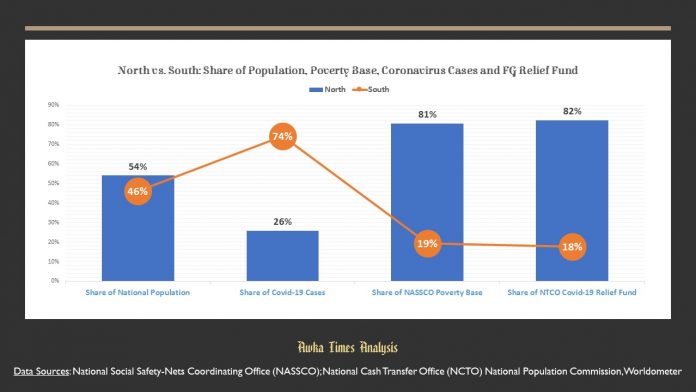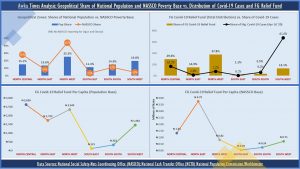The current distribution of federal relief funds as coronavirus infection spreads in Nigeria has raised questions of distributive equity, with growing complaints of lopsided distribution to the North. However, Awka Times analysis shows that current distributions may be targeted more at chronic poverty alleviation rather than addressing the specific exigencies of the coronavirus scourge, a policy choice that may still rankle in some parts of the country.
By Chudi Okoye
Amidst the swelling incidences of coronavirus infection in Nigeria, with more of the country on lockdown as part of the containment effort, the federal government of Nigeria has commenced the distribution of relief funds to the most vulnerable members of the society. However, there is confusion about the government’s priorities as cash transfers so far do not appear to align with known facts about the distribution of coronavirus infections in the country.
There is probably some virtuous logic behind the current distribution of federal relief funds, but it is not obvious on cursory analysis.
Creeping Count of Coronavirus Cases
With the official count of coronavirus in Nigeria at 442 as of 16 April 2020, Nigeria remains in the lower rungs of continental and global ranking of the pandemic scourge. It is currently 12th in Africa and 98th in the world. Despite the relatively low ranking, within the country itself there is wide disparity in reported incidences of coronavirus.
The latest update of confirmed coronavirus cases indicates that 19 of the country’s 36 states and the federal capital Abuja have reported incidences of the disease.
In terms of geopolitical spread, the South West remains the only zone with all its constituent states reporting confirmed Covid-19 cases. The zone so far has reported 67.4% of the total confirmed cases in Nigeria, with Lagos State alone reporting 56.8% of nationwide cases. This is no doubt correlated with the skewed availability of testing facilities in the state.
Abuja FCT is another heavily impacted area with 15.2% of the total conformed cases in Nigeria. The North Central zone within which the FCT is located has in total about 16.7% of the national tally, with cases also reported in Niger, Benue and Kwara states located in that zone.
The South South zone, with four of its six states reporting confirmed cases, has 6.1% of the national total.
The North West zone has 7.7% of the national total, with reported cases in Kano, Kaduna and Katsina states.
The remaining geopolitical zones appear as yet to have miniscule exposure to the coronavirus contagion. North East has 1.4% of the national record, with cases there reported only in Bauchi State. The South East zone – where Anambra and Enugu states have so far reported a single case each – brings up the rear with 0.7%.
The threat of coronavirus spread has forced federal and state governments in Nigeria to impose social distancing guidelines, with schools, public institutions and centres of economic activity shuttered in most parts of the country. The new guidelines are being enforced with varying levels of strictness and dexterity.
Focusing the Federal Funds
The lockdown was bound to unleash severe disruptions and hardships, the effect of which appears to bear most heavily on the poorest segments of the society. For this reason, across the country private individuals, civic groups as well as state governments are making strenuous efforts to provide palliative packages to the most imperilled parts of the population.
The federal government too has initiated its own relief programme. It is leveraging the National Social Safety Nets Project (NASSP), which is supported by the World Bank, to provide financial support to poor and vulnerable households in Nigerian. A component agency of this project, the National Social Safety-Nets Coordinating Office (NASSCO) recently released what it calls the “National Social Register of Poor & Vulnerable Households” which, according to the agency, is “built through a rigorous, transparent community-based targeting process undertaken by states and validated by NASSCO.” The agency’s register is updated to 31 March 2020, and calibrates the targeted households and corresponding populations by state.
Shortly after the release of the poverty register, another component agency of NASSP, the National Cash Transfer Office (NCTO), was activated to begin the release of what was touted as Covid-19-related relief funds to targeted households. The new disbursement is based on the National Cash Transfer Programme (also known as Household Uplifting Programme, HUP) which is said to be one of the “social investment programmes anchored by the Federal Government of Nigeria.” This programme had been established in 2016 with World Bank support.
Data is now available for the distributions made so far under the scheme. Awka Times dug into the available data, triangulating it against the overall national population and also the distribution of coronavirus cases so far reported across the states of Nigeria. For simplicity and political salience, we calibrated the analysis by geopolitical zone.
The result of our analysis is presented in an easily-accessible dashboard.
▲ Click to enlarge
Analysis of the Paralysis
The results of the analysis are intriguing. Part of the results seem intuitive, probably in line with known facts about the spread of prosperity in the country. For instance, the Southern geopolitical zones constitute about 46% of the Nigerian population but yield only 19.3% of NASSCO’s registered poor. On the other hand, the Northern geopolitical zones, comprising 54% of the population, produce 80.7% of the registered poor.
A breakdown shows that the South East region, according to aggregated census data, represents about 11.7% of the national population whereas it constitutes merely 3.5% of NASSCO’s tally of the extreme poor. The South West geopolitical zone, with 19.8% of the population, registers 4.6% of the extreme poor. And the South South zone, with 14.9% of the population, produces 11.2% of the poor.
In other words, all the Southern geopolitical zones under-index their population share in the poverty register.
The Northern states, on the other hand, mostly over-index their population share in the poverty track. The North West, with 25.3% of the population, produces a whopping 44.2% of the desperate poor in Nigeria. The North Central zone, with 15.1% of the national population, yields about 28.1% of the extreme poor. The North East, however, with 13.6% of the population, throws up 8.4% of the registered poor, thus on the current tally under-indexing its population share.
Awka Times analysis shows that while the distribution of the federal government’s Covid-19 relief funds aligns with the poverty skew in the country, it is rather inversely correlated with the actual distribution of coronavirus cases in the country. Aggregated data as of April 16 shows that 74.2% of coronavirus cases were reported in the Southern geopolitical zones, far outstripping the 25.8% reported in the North.
On the other hand, the bulk of the federal relief fund so far released, 82.3%, has been released to recipients in the North. The disbursement aligns with the concentration of poverty in the North but it is woefully misaligned with the concentration of coronavirus cases in the South. The most glaring case is in the North West zone: with 44.2% of the registered poor, the geopolitical zone has received 37.8% of the federal relief funds even though it has only 7.7% of the country’s confirmed coronavirus cases.
It may be a matter of policy preference: whether to target palliative provisions at the alleviation of chronic poverty in general or at the poor who are likely the most impacted by the exigent hardships engendered by the coronavirus pandemic. It is a policy choice, and so far it appears that the federal authorities have preferred the former, choosing the alleviation of chronic poverty over the exigencies of the current health scare.
Policy choices are often moral choices. It is a matter of debate whether the federal government’s current preference is the right one.




